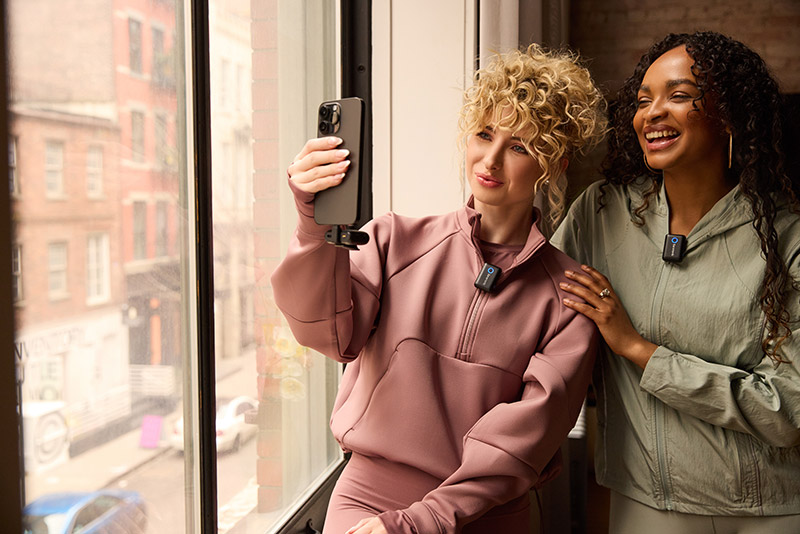Facing a whole list of Saramonic wireless lavalier microphones yet don't know which one to choose? You've come to the right place. In this blog, we will walk you through all the options Saramonic offers — no matter if you're simply beginning to create or have years' experience. After this 3-minute reading, you should be able to decide which one works the best for you based on your use and budget.

On the spec page of every wireless lav mic, there are technical terms that provide the overview of the whole system. Let's break it down for clarity.
RF and Bluetooth are the two transmission methods you can find on a wireless audio system, with RF standing for radio frequency. Most consumer-grade wireless lav mics operate in 2.4 GHz frequency, which is also adopted by other everyday electronic devices such as Wi-Fi routers, wireless keyboards, and wireless mouses. You may also find UHF (Ultra High Frequency) devices on the market, which are made for filmmakers.
Frequency response is the frequency range a microphone can respond to. The wider the range, the more sounds it can pick up. For human ears, this range is between 20 Hz and 20 kHz, which is also the range most Saramonic wireless lav mics use: From deep rumbles at 20 Hz to 85 - 2.5 kHz where most human voices and instruments sit and all the way from 2.5 kHz to 20 kHz that accomodate bright sounds, such as bird chirps.
Polar pattern is oftentimes called pickup pattern, which means how the microphone picks up sounds. You may find yourself reading omnidirectional, cardioid, super-cardioid, and figure 8 on the spec sheet. A microphone with an omnidirectional (omni) polar pattern picks up sounds equally from 360°, cardioid (heart-shaped) from the front and a little bit from the side, super-cardioid from the front with an even narrower pickup area and a little bit from the rear, and figure 8 from the front and rear while rejecting the sides. Most wireless lav mics in the market feature an omni pattern, which is beneficial when the sound capture remains consistent no matter how the you move your head.
Sample rate, measured in Hz and kHz, is the number of times a microphone samples a sound source. The higher the sample rate, the more details it captures. You may find sample rates that go from 16 kHz, to 44.1 kHz (CD quality), to 48 kHz (movie and video standard), and all the way to 96 kHz (high-res audio).
Bit depth measures the number of levels of "loudness" from quiet to loud. Usually in a wireless lavalier microphone, you can find 16-bit, 24-bit, and 32-bit float. The higher the number, the more levels of "loudness" the recordings will have, and the more accurate the recordings will be. So aim for high bit depth within your budget.
SNR, or Signal to Noise Ratio, is the comparison between the signal and noise, with signal being the intended sound you want to to record and noise being the microphone's self-noise - the hissing sound produced by the microphone itself that you hear in the background, especially in those quiet recordings. The SNR is measured in decibel. The higher the number, the better the audio quality. For example, you want to aim for at least 80 dB in SNR to produce the desired clean audio, otherwise, you may spend a lot of time editing out the noise in post production.
The transmission range matters if your content creation involves you recording from a place faraway from the receiver. Line of Sight means that the space between the transmitter and receiver has no physical obstruction — no human body or walls. The longer the LoS, the better the signal strength.
Introduced to the market back in early 2024, Blink500 B2+ is a great wireless lav mic designed for beginning creators. Priced at US$129, this dual-channel system features two transmitters, one receiver, and one charging case. The system is future-proof with the included lightning and USB-C adapters and the 3.5 mm TRS to TRS audio cable, allowing creators to work it with phones, tablets, computers, and cameras.
Made for beginners but Blink500 B2+ is not compromised on sound quality. With the SNR at 80 dB, Sample Rate/Bit depth at 48 kHz / 24 bit, the microphone captures and highlights the desired sound source, making it more about the human voice than the microphone's self noise. 48 kHz provides enough room to accomodate human voice (up to 20 kHz) and outperforms CD at 44.1 kHz. The 24 bit allows creators to boost quiet moments without inviting much self noise.

If you're creating with phone and camera at the same time for both vertical (Instagram) and horizontal (YouTube), Blink500 B2+ might be your go to choice because it can output to two devices at the same time — ideally camera and phone. This would save you a lot of editing efforts in post production. And this feature can only be found in this model.
Saramonic Mix was launched early in March of 2025 for creators who seek a high price/performance ratio: a step closer to professional performance but priced at US$169, which is lower than the pro line up.
Same as Blink500 B2+, the dual-channel wireless microphone also features two transmitters and one receiver. The biggest difference between the two systems is that Saramonic Mix has a mic-in port that connects to an external lav mic, so your on-camera look can appear more professional and logo-free. In addition, Saramonic Mix has a pro chip that is much more efficient than the beginner's model. The benefits of the pro chip can be found in AFH (Automatic Frequency Hopping) that enables the microphone to find the cleanest channel for transmission among RF clutters, for example: livestreaming at an exhibition to an online audience; the 7 ms ultra-low latency for audio-video sync; AGC that automatically balances gain levels across settings so your recordings can remain consistent.

Saramonic Ultra — the for-pro wireless lav mic, was introduced to the market in November of 2024. This dual-channel lavalier microphone is packed with as many professional features as there are on the market: 32-bit float onboard recording for safety backup and ample room for post edits; timecode for audio-video sync with cameras and other microphone systems; 130 dB max SPL for recording extremely loud sound sources without clippings; IPX5-rated water resistance for surviving rain and splashes; and external antenna for boosting the transmission range from 250 to 300 meters.

The Saramonic Ultra represents the company's lastest audio technologies and is priced at US$269 (without wired lav mics) and US$299 (with wired lav mics).
On the opposite of hiding logos and the microphone all together, BlinkMe B2 and BlinkMe U2 were designed with creators with big personalities in mind. This lineup features a touchscreen that allows users to customize with their own name or logo, so the microphone can serve as a showpiece to tell the audience more about their personal branding and personality.

As indicated by its name, Blink500 T4 features 4 transmitters, which means that you can mic up to four talents for a group interview.
The Saramonic team designs and presents wireless lav mics with creators of all levels in mind — Blink500 B2+ for beginning creators, Saramonic Mix for creators who want to get a step closer to professional performance without breaking their bank, Saramonic Ultra for professional creators who look for all pro features that streamline their workflow, BlinkMe B2 and U2 for creators who want to make their on-camera look all about them with the customizable touchscreen, and Blink500 T4 for group interviews with four transmitters to mic up up to four talents.
The company is committed to innovating their products to stay relevant to the creator community. Head to Saramonic Official Online Store to learn more and buy now.